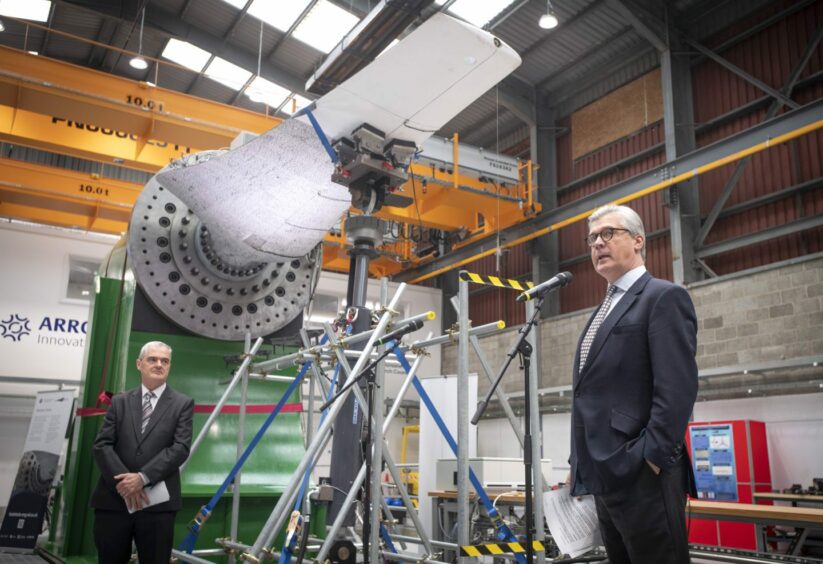
The rising costs and security issues of fossil-based fuels combined with global aspirations to address climate change, are driving the development of wind and solar energy.
However, the wind doesn’t always blow and Scotland’s “Sunshine on Leith” can be missing for long periods of the year, making tidal stream energy an increasingly attractive renewable energy alternative.
The UK Government’s announcement earlier this month of revenue support for 40 MW of tidal stream energy projects in Scotland and Wales is a significant step towards the development of this nascent industry.
As we look to further exploit this valuable source of energy, May 2022 also saw the launch of FastBlade, the world’s first rapid testing facility for tidal turbine blades to ensure they are able to endure harsh ocean conditions for several years. The £4.6m facility based at Fife’s Rosyth Dockyard, can speed up development of marine energy technologies while helping to reduce costs.
FastBlade provides a sterling example of how university research projects are helping companies reduce the current cost of tidal stream energy and make it more viable in powering homes, public buildings and businesses.
The development of marine renewable energy (wave, tidal stream and offshore wind energy) has been a major research activity of the School of Engineering at the University of Edinburgh for more than 40 years. Despite several false starts, development in marine renewables has continued, with the support of Government bodies such as Wave Energy Scotland and EPSRC, Innovate UK and European Union research and development programmes.
In terms of tidal stream energy, we have an enormous, predictable source of unharnessed energy here in Europe and particularly around UK waters, including in the north of Scotland. While there is up to an estimated 10GW of predictable, high value tidal stream potential in European waters, the capacity figure is upwards of 100GW globally, underlining its potential as a reliable and sustainable source of power for the future.
For these reasons, many universities remain committed to investing resources to further develop tidal energy capacity. Our key focus is on educating well-trained engineers, scientists and business graduates; and by providing advanced testing and certification facilities to support the industry in improving and perfecting its device designs.
The University of Edinburgh’s world-leading Flowave circular tank, set up in 2013 for wave and tidal testing of marine renewable energy devices, has played a key role in that aspiration. Flowave has now become an essential part of companies’ path to development by de-risking the device designs at an early stage.
The FastBlade project has now come to fruition as the tidal stream energy industry is about to enter its commercialisation phase with many tidal farms due to be built around UK coasts in the next few years. The design of the fibre-reinforced composite blades that are used to generate the power is not straightforward, however, and can’t be de-risked by learning from their much longer wind turbine blade cousins. Tidal blades must last for 20-25 years in very aggressive conditions and must reliably produce power for their lifetime.
FastBlade will help the industry in testing and certifying their turbine blades at the new testing facility in Rosyth. Funded initially by a £1.8m EPSRC grant, and with an added £2.8m funding from the University, FastBlade was developed in partnership with Babcock International Group and can test and certify full-scale tidal blades. The facility is also available to researchers to investigate new manufacturing techniques and materials.
FastBlade uses super-efficient Digital Displacement Hydraulics® (developed by a spinout company of the University, now part of the multinational Danfoss group) to do regenerative hydraulic pumping. This enables full lifetime accelerated fatigue loading of tidal turbine blades to be carried out in a matter of months, thereby verifying the design methodologies and greatly reducing the risk of blade failures during the lifetime of the turbines.
With growing international pressure for governments around the globe to develop viable energy solutions that will help the transition to net zero, tidal energy offers immense potential. This will, however, require investment from multiple bodies. The university sector working alongside key industry players has a critical role to play in fully exploiting this opportunity for the benefit of the entire planet. We look forward to our continued engagement in the journey that lies ahead.
Professor Conchúr Ó Brádaigh is head of the School of Engineering at the University of Edinburgh.
Recommended for you
